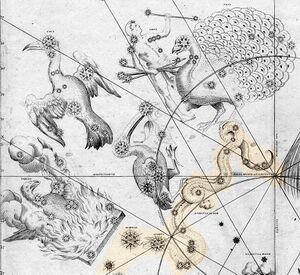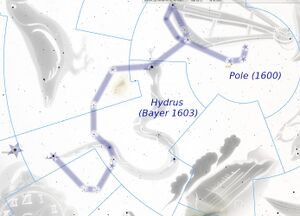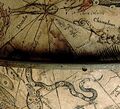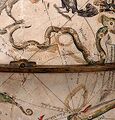Hydrus: Difference between revisions
(Created page with "One of the 88 IAU constellations. ==Etymology and History== The Greek constellation ... === Origin of Constellation === === Transfer and Transformation of the Constellation === == Greek Mythology == == Weblinks == * == References == * References (general) * References (Babylonian) * References (ancient Greco-Roman) * References (medieval) [...") Tag: Disambiguation links |
|||
| (37 intermediate revisions by 3 users not shown) | |||
| Line 1: | Line 1: | ||
[[File:Hydrus IAU.svg|alt=star chart|thumb|star chart,CC BY IAU and Sky & Telescope magazine (Roger Sinnott & Rick Fienberg)]] |
|||
One of the [[:Category:88_IAU-Constellations|88 IAU constellations]]. |
|||
[[File:Plancius-hydrus hi.jpg|thumb|Hydrus in Plancius (1596): it is obvious that he reworked the tail of the snake. ]] |
|||
One of the [[:Category:88_IAU-Constellations|88 IAU constellations]]. The constellation Hydrus, known as the Lesser Water Snake, is located in the southern celestial hemisphere, positioned between the Large and Small Magellanic Clouds. It is notable for being near the celestial south pole. |
|||
==Etymology and History== |
==Etymology and History== |
||
[[File:1024px-Johann Bayer - Uraniometria - Hydrus.jpg|thumb|Bayer (1603): Constellation Hydrus. His Hydrus has 15 stars as in de Houtman's catalogue.]] |
|||
The Greek constellation ... |
|||
[[File:Hydrus stellarium.jpg|thumb|Hydrus from Bayer (1603) mapped to Stellarium, WGSN 2025.]] |
|||
The often-cited analogy to the great water snake is not convincing because the constellation looks completely different. A ‘snake line’ is also unimaginative as any collection of points can ultimately be connected to form a snake line. |
|||
=== Origin of Constellation === |
=== Origin of Constellation === |
||
[[File:DeHoutman VVaterslang.jpg|thumb|screenshot of de Houtman's 1603 first catalogue of stars in Hydrus; notethe typesetting of the "W" featured as 2 "V"s.]] |
|||
It seems that the Dutch navigators, Pieter Keyser and Frederick de Houtman, who navigated the Eerste Schipvaart from Europe via Madagasscar to the East Indies, continued the line of the ancient river southwards to the star [[Achernar]] and evern further south. Hydrus begins next to Achernar, the brightest star in the constellation River. The star we call Achernar today was added to the river only in early modern times. The Arab Bedouins may have used it for orientation a few centuries earlier. However, the Arabic name Achernar for ‘end of the river’ was transferred from ϑ Eridani to this star in early modern times and refers to the Ptolemaic constellation The River ([[Eridanus]]). |
|||
==== Navigational Tool? ==== |
|||
At least in Bayer's '''Uranometria (1603)''', it looks as if Hydrus served to find the position of the Celestial South Pole by star hopping. |
|||
The shape of the curls close to the head of Hydrus resembles the shape of the northern part of Eridanus (close to Orion's foot), and the curved line meanders down to the south pole (marked on the map as the cross section of the colure circles). The tip of the water '''snake's tail is next to the South Pole.''' This view seems to be supported by '''Paulus Merula''' in his ''Cosmographiae generalis libri tres'' (1605) as one of the name alternatives he gives as "'''Hydrus Polaris'''". |
|||
The celestial globe by Plancius and Hondius (1598) is lost, but preserved is a copy of it by Blaeu (1602). A year later, Blaeu made a second globe. The celestial '''globe by Blaeu''' 1603 who directly used de Houtman's original data, again changed the tail of Hydrus - now pointing upwards/ forward in the image (northeastwards), but still conisting of the same stars<sup>?</sup>. |
|||
So perhaps, the curly watery line pointing due south is a creation by Plancius, Hondius or Bayer: Plancius's had corrected the southern end of Hydrus for his 1598 globe. A draft of the globe gores that dates a few years ealier shows that his original version almost touched the south pole, too - and Bayer probably had access to the earlier version and perhaps to Merula's terminlogy. |
|||
==== De Houtman's Version ==== |
|||
[[File:Blaeu1603 Hydrus.JPG|thumb|Blaeu (1603), based on de Houtman's data, Hydrus changed [https://collections.rmg.co.uk/mediaLib/398/media-398216/large.jpg (RMG)].]] |
|||
Due to political circumstances, the original author, Frederick de Houtman, published his star catalog only in 1603 - after the first globe by Plancius and Hondius and simultaneously with Bayer's Uranometria. |
|||
The southernmost star in his list is the 11<sup>th</sup> star in the tail of the “Waterslanghe” at declination −83° 40′, now called β Octantis (mag 4.13), as Lacaille (1756) took the stars at the south pole to place a newly invented navigational tool there, the octant ([[Octans]]). This is not compatible with both contemporary globes by Plancius and Bayer: in Plancius, the third and fourth star are closest to the pole, and in Bayer, it is the 15th star. |
|||
{| class="wikitable" |
|||
! |
|||
!de Houtman (1603) |
|||
! colspan="2" |Knobel (1914)<ref>Knobel (1917). MNRAS..77..414K<nowiki/>https://ui.adsabs.harvard.edu/abs/1917MNRAS..77..414K/abstract</ref> |
|||
after: Uranometria Argentina |
|||
|- |
|||
|1 |
|||
|The head of the water-snake |
|||
|alf Hyi |
|||
|α Hyi |
|||
|- |
|||
|2 |
|||
|One star in the neck |
|||
|bet Hor |
|||
|β Hor |
|||
|- |
|||
|3 |
|||
|The second following |
|||
|zet Hyi |
|||
|ζ Hyi |
|||
|- |
|||
|4 |
|||
|The third " |
|||
|eps Hyi |
|||
|ε Hyi |
|||
|- |
|||
|5 |
|||
|The fourth " |
|||
|del Hyi |
|||
|δ Hyi |
|||
|- |
|||
|6 |
|||
|The fifth is above the small nebula (Nubecula minor) |
|||
|lam2 Tuc |
|||
|λ<sub>2</sub> Tuc |
|||
|- |
|||
|7 |
|||
|The sixth following |
|||
|pi Tuc |
|||
|π Tuc |
|||
|- |
|||
|8 |
|||
|the seventh " |
|||
|_ Tuc |
|||
|_ Tuc |
|||
|- |
|||
|9 |
|||
|A star above the preceeding one. |
|||
The small nebula |
|||
|_ Tuc |
|||
SMC |
|||
|_ Tuc |
|||
SMC |
|||
|- |
|||
|10 |
|||
|The ninth following |
|||
|bet Hyi |
|||
|β Hyi |
|||
|- |
|||
|11 |
|||
|The tenth " |
|||
|tet Oct |
|||
|θ Oct |
|||
|- |
|||
|12 |
|||
|The eleventh situated in the tail |
|||
|bet Oct |
|||
|β Oct |
|||
|- |
|||
|13 |
|||
|The end of the tail |
|||
|nu Oct |
|||
|ν Oct |
|||
|- |
|||
|14 |
|||
|One before the breast of the water-snake |
|||
|bet Ret |
|||
|β Ret |
|||
|- |
|||
|15 |
|||
|One situated below the last |
|||
|gam Hyi |
|||
|γ Hyi |
|||
|} |
|||
==== Solving a Problem in the Almagest ==== |
|||
A problem that had already been historical in early modern time, is a confusing statement in the Almagest: Hopping southwards from Orion's foot, Ptolemy's Almagest (137 CE) reports the last star in Eridanus ‘the brightest’. This star at the southern endpoint of the classical River constellation is ϑ Eridani (3.2 mag). In contrast, the brightest star in the ancient chain is β Eridani (2.75 mag) at the northern end of the river. The confusion in the Almagest likely occurred because the author was not an astronomical observer, as ancient literature authors argue whether the river flows from north to south or south to north. |
|||
Yet, after the extension of the River by Keyser and de Houtman, the brightest star could really be placed at the (southern) end of the river. That might have given a strong argument for the acceptance of this suggestion: with the extension of Eridanus to the star now called "Achernar" (and not further south, down the curly line of Hydrus!), the southernmost star of Eridanus was indeed the "last" and the "brightest" (0.45 mag) in the River. Calling the rest of the snake line ‘water snake’ then seems like a pun or a play on words (‘snake of water’?). |
|||
==== Terminology ==== |
|||
{| class="wikitable" |
|||
|+ |
|||
!author |
|||
!year |
|||
! |
|||
!term |
|||
!English |
|||
|- |
|||
|de Houtman |
|||
|1603 |
|||
|Star Catalog |
|||
|de VVaterslang |
|||
|Water Snake |
|||
|- |
|||
|Bayer |
|||
|1603 |
|||
|Uranometria (Maps) |
|||
|Hydrus |
|||
| |
|||
|- |
|||
|Merula |
|||
|1605 |
|||
|''Cosmographiae generalis libri tres'' |
|||
* Part I, Book II, pp. 105-108 |
|||
* no. IX |
|||
| |
|||
* Hydrus Polaris |
|||
* Hydrus Pelaru(?) |
|||
* Water-slanghe |
|||
| |
|||
|- |
|||
|Lacaille |
|||
|1756 |
|||
| |
|||
|l'hydre male |
|||
|Male Water Snake |
|||
|} |
|||
'''Remark 1:''' The first book of Merula's ''Cosmographiae'' was written mostly in 1597 and in a letter, dated 30 August 1600, to Marcus Welser in Augsburg, Merula claims that the first part of his work was ready to be printed. It might have influenced Bayer's work, too (e.g. be the reason for Bayer to draw Hydrus to the pole). Note that Hydrus's tail was reworked on Plancius's globe; the earlier (erased) version was closer to the pole. |
|||
We suspect that Merula's description is based on a list which he received from Plancius around 1597/98 when was he still busy forming his constellations. For a few constellations, he had not yet decided which figures and names would finally be shown on his celestial globe; e.g. the constellations [[Volans]], [[Grus]] and [[Apus]] also were given with alternative names. |
|||
'''Remark 2:''' The term "hydrus" is Latin male, as opposed to "hydra", a female watersnake. Yet, nobody knows how early modern astronomers distinguished male and female watersnakes in the sky. |
|||
=== Transfer and Transformation of the Constellation === |
=== Transfer and Transformation of the Constellation === |
||
Originally an extension of Eridanus, creating a meandering chain of stars which flows close to the celestial south pole. |
|||
* Bayer (1603) draws the tail tip of Hydrus as a marker of the south pole. |
|||
* On Blaeu’s globe of 1602, copied from Plancius and Hondius (1598), it follows much the same path as on Bayer’s atlas, but without Bayer's artistic coils. |
|||
* Blaeu made a second globe the following year, this time from de Houtman’s catalogue. On this globe the tail of Hydrus ends in quite a different position, under the feet of Pavo and pointing away from Apus. |
|||
* In de Houtman’s catalogue the tip of the tail ended at the star we now know as ν Octantis, which is actually the brightest star in Octans. |
|||
* Lacaille’s version passes between the two Magellanic Clouds, transferring some of its stars to Tucana and chopping off its tail to make way for Octans. |
|||
<gallery> |
|||
File:Hydrus Plancius+Hondius.JPG|Hydrus on the celestial globe by Plancius/ Hondius (1597/8) |
|||
File:Plancius-hydrus hi.jpg|Hydrus in Plancius (1598). Note that the end was reworked: the first (erased) version went towards the pole, just like Bayer's (1603) version. |
|||
File:Hydrus Blaeu.JPG|Hydrus on Blaeu's Globe (Willem Jansz.Blaeu, 1603, second globe, based on de Houtman's data). |
|||
File:1024px-Johann Bayer - Uraniometria - Hydrus.jpg|Bayer (1603): Constellation Hydrus (CC0) |
|||
File:Hydrus Keere+Plancius1612.JPG|Hydrus on the van der Keere & Plancius (1612) globe, it does not deviate from Plancius' 1598 version. |
|||
File:Lacaille’s southern planisphere of 1756.png|In Lacaille's map of the celestial south (1756), the tail of Hydrus is modified to place Octans (a newly invented nautical instrument) at the celestial south pole |
|||
File:Hyi Fortin1795.jpg|Hydrus in Fortin's Atlas Céleste, 3rd edition (1795). |
|||
File:Eri+Hyi stellarium.png|Eridanus and Hydrus in Stellarium (modern map, 2024) |
|||
</gallery> |
|||
== Greek Mythology == |
== Greek Mythology == |
||
No ancient mythology. |
|||
== Weblinks == |
|||
== IAU WGSN Names == |
|||
* |
|||
In 2023, it was proposed to use the original name of the constellation (in any of its forms) as a star name. The first depiction on the Hondius/Plancius globe shows the form "Waterslange". It might be an idea to use this term for the brightest star in Hydrus or for a star close to the south pole in constellation Octans in order to create public visibility of the fact that constellations are human-made and were changed over time (without the motion of stars). alf Hyi is an F-type (yellow) main sequence-star (V=2.84 mag, [https://simbad.cds.unistra.fr/simbad/sim-id?Ident=alf+Hyi&NbIdent=1&Radius=2&Radius.unit=arcmin&submit=submit+id SIMBAD]), tau Oct was closest to the pole in 1600 and the southernmost star in de Houtman’s 1603 catalogue is the 11<sup>th</sup> star in the tail of the “Waterslanghe” at declination −83° 40′, or β Octantis (mag 4.13), a high proper motion star of white A-type ([https://simbad.cds.unistra.fr/simbad/sim-id?Ident=bet+Oct&NbIdent=1&Radius=2&Radius.unit=arcmin&submit=submit+id SIMBAD]). |
|||
== Weblinks == |
|||
* Ridpath, Ian, "[http://www.ianridpath.com/startales/hydrus.html Star Tales: online edition]". |
|||
== References == |
== References == |
||
| Line 23: | Line 199: | ||
* [[References (Medieval and Early Modern)|References (medieval)]] |
* [[References (Medieval and Early Modern)|References (medieval)]] |
||
[[Category:Eurasia]] [[Category:Constellation |
[[Category:Eurasia]] [[Category:Constellation]] [[Category:Modern]] |
||
[[Category:88 IAU-Constellations]] |
[[Category:88 IAU-Constellations]] |
||
Latest revision as of 19:18, 3 May 2025
One of the 88 IAU constellations. The constellation Hydrus, known as the Lesser Water Snake, is located in the southern celestial hemisphere, positioned between the Large and Small Magellanic Clouds. It is notable for being near the celestial south pole.
Etymology and History
The often-cited analogy to the great water snake is not convincing because the constellation looks completely different. A ‘snake line’ is also unimaginative as any collection of points can ultimately be connected to form a snake line.
Origin of Constellation
It seems that the Dutch navigators, Pieter Keyser and Frederick de Houtman, who navigated the Eerste Schipvaart from Europe via Madagasscar to the East Indies, continued the line of the ancient river southwards to the star Achernar and evern further south. Hydrus begins next to Achernar, the brightest star in the constellation River. The star we call Achernar today was added to the river only in early modern times. The Arab Bedouins may have used it for orientation a few centuries earlier. However, the Arabic name Achernar for ‘end of the river’ was transferred from ϑ Eridani to this star in early modern times and refers to the Ptolemaic constellation The River (Eridanus).
At least in Bayer's Uranometria (1603), it looks as if Hydrus served to find the position of the Celestial South Pole by star hopping.
The shape of the curls close to the head of Hydrus resembles the shape of the northern part of Eridanus (close to Orion's foot), and the curved line meanders down to the south pole (marked on the map as the cross section of the colure circles). The tip of the water snake's tail is next to the South Pole. This view seems to be supported by Paulus Merula in his Cosmographiae generalis libri tres (1605) as one of the name alternatives he gives as "Hydrus Polaris".
The celestial globe by Plancius and Hondius (1598) is lost, but preserved is a copy of it by Blaeu (1602). A year later, Blaeu made a second globe. The celestial globe by Blaeu 1603 who directly used de Houtman's original data, again changed the tail of Hydrus - now pointing upwards/ forward in the image (northeastwards), but still conisting of the same stars?.
So perhaps, the curly watery line pointing due south is a creation by Plancius, Hondius or Bayer: Plancius's had corrected the southern end of Hydrus for his 1598 globe. A draft of the globe gores that dates a few years ealier shows that his original version almost touched the south pole, too - and Bayer probably had access to the earlier version and perhaps to Merula's terminlogy.
De Houtman's Version
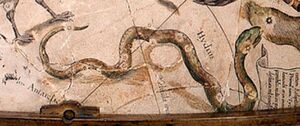
Due to political circumstances, the original author, Frederick de Houtman, published his star catalog only in 1603 - after the first globe by Plancius and Hondius and simultaneously with Bayer's Uranometria.
The southernmost star in his list is the 11th star in the tail of the “Waterslanghe” at declination −83° 40′, now called β Octantis (mag 4.13), as Lacaille (1756) took the stars at the south pole to place a newly invented navigational tool there, the octant (Octans). This is not compatible with both contemporary globes by Plancius and Bayer: in Plancius, the third and fourth star are closest to the pole, and in Bayer, it is the 15th star.
| de Houtman (1603) | Knobel (1914)[1]
after: Uranometria Argentina | ||
|---|---|---|---|
| 1 | The head of the water-snake | alf Hyi | α Hyi |
| 2 | One star in the neck | bet Hor | β Hor |
| 3 | The second following | zet Hyi | ζ Hyi |
| 4 | The third " | eps Hyi | ε Hyi |
| 5 | The fourth " | del Hyi | δ Hyi |
| 6 | The fifth is above the small nebula (Nubecula minor) | lam2 Tuc | λ2 Tuc |
| 7 | The sixth following | pi Tuc | π Tuc |
| 8 | the seventh " | _ Tuc | _ Tuc |
| 9 | A star above the preceeding one.
The small nebula |
_ Tuc
SMC |
_ Tuc
SMC |
| 10 | The ninth following | bet Hyi | β Hyi |
| 11 | The tenth " | tet Oct | θ Oct |
| 12 | The eleventh situated in the tail | bet Oct | β Oct |
| 13 | The end of the tail | nu Oct | ν Oct |
| 14 | One before the breast of the water-snake | bet Ret | β Ret |
| 15 | One situated below the last | gam Hyi | γ Hyi |
Solving a Problem in the Almagest
A problem that had already been historical in early modern time, is a confusing statement in the Almagest: Hopping southwards from Orion's foot, Ptolemy's Almagest (137 CE) reports the last star in Eridanus ‘the brightest’. This star at the southern endpoint of the classical River constellation is ϑ Eridani (3.2 mag). In contrast, the brightest star in the ancient chain is β Eridani (2.75 mag) at the northern end of the river. The confusion in the Almagest likely occurred because the author was not an astronomical observer, as ancient literature authors argue whether the river flows from north to south or south to north.
Yet, after the extension of the River by Keyser and de Houtman, the brightest star could really be placed at the (southern) end of the river. That might have given a strong argument for the acceptance of this suggestion: with the extension of Eridanus to the star now called "Achernar" (and not further south, down the curly line of Hydrus!), the southernmost star of Eridanus was indeed the "last" and the "brightest" (0.45 mag) in the River. Calling the rest of the snake line ‘water snake’ then seems like a pun or a play on words (‘snake of water’?).
Terminology
| author | year | term | English | |
|---|---|---|---|---|
| de Houtman | 1603 | Star Catalog | de VVaterslang | Water Snake |
| Bayer | 1603 | Uranometria (Maps) | Hydrus | |
| Merula | 1605 | Cosmographiae generalis libri tres
|
|
|
| Lacaille | 1756 | l'hydre male | Male Water Snake |
Remark 1: The first book of Merula's Cosmographiae was written mostly in 1597 and in a letter, dated 30 August 1600, to Marcus Welser in Augsburg, Merula claims that the first part of his work was ready to be printed. It might have influenced Bayer's work, too (e.g. be the reason for Bayer to draw Hydrus to the pole). Note that Hydrus's tail was reworked on Plancius's globe; the earlier (erased) version was closer to the pole.
We suspect that Merula's description is based on a list which he received from Plancius around 1597/98 when was he still busy forming his constellations. For a few constellations, he had not yet decided which figures and names would finally be shown on his celestial globe; e.g. the constellations Volans, Grus and Apus also were given with alternative names.
Remark 2: The term "hydrus" is Latin male, as opposed to "hydra", a female watersnake. Yet, nobody knows how early modern astronomers distinguished male and female watersnakes in the sky.
Transfer and Transformation of the Constellation
Originally an extension of Eridanus, creating a meandering chain of stars which flows close to the celestial south pole.
- Bayer (1603) draws the tail tip of Hydrus as a marker of the south pole.
- On Blaeu’s globe of 1602, copied from Plancius and Hondius (1598), it follows much the same path as on Bayer’s atlas, but without Bayer's artistic coils.
- Blaeu made a second globe the following year, this time from de Houtman’s catalogue. On this globe the tail of Hydrus ends in quite a different position, under the feet of Pavo and pointing away from Apus.
- In de Houtman’s catalogue the tip of the tail ended at the star we now know as ν Octantis, which is actually the brightest star in Octans.
- Lacaille’s version passes between the two Magellanic Clouds, transferring some of its stars to Tucana and chopping off its tail to make way for Octans.
Greek Mythology
No ancient mythology.
IAU WGSN Names
In 2023, it was proposed to use the original name of the constellation (in any of its forms) as a star name. The first depiction on the Hondius/Plancius globe shows the form "Waterslange". It might be an idea to use this term for the brightest star in Hydrus or for a star close to the south pole in constellation Octans in order to create public visibility of the fact that constellations are human-made and were changed over time (without the motion of stars). alf Hyi is an F-type (yellow) main sequence-star (V=2.84 mag, SIMBAD), tau Oct was closest to the pole in 1600 and the southernmost star in de Houtman’s 1603 catalogue is the 11th star in the tail of the “Waterslanghe” at declination −83° 40′, or β Octantis (mag 4.13), a high proper motion star of white A-type (SIMBAD).
Weblinks
- Ridpath, Ian, "Star Tales: online edition".
References
- ↑ Knobel (1917). MNRAS..77..414Khttps://ui.adsabs.harvard.edu/abs/1917MNRAS..77..414K/abstract


